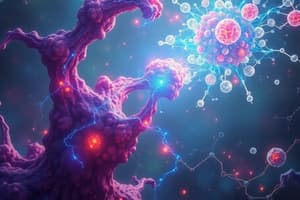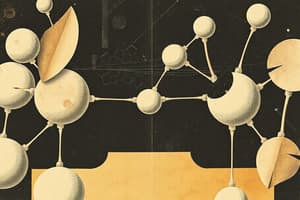Podcast
Questions and Answers
What is the correct IUPAC name for the following molecule: CH3-CH2-CH(CH3)-CH2-CH3?
What is the correct IUPAC name for the following molecule: CH3-CH2-CH(CH3)-CH2-CH3?
- 2-Ethylbutane
- 2-Methylpentane
- 1-Methylpentane
- 3-Methylpentane (correct)
Which of the following molecules would be classified as an alkane?
Which of the following molecules would be classified as an alkane?
- CH3-CH2-CH=CH2
- CH3-CH2-OH
- CH3-CH2-CH2-CH3 (correct)
- CH3-CH2-C≡CH
What is the correct IUPAC name for the following molecule: CH3-CH2-CH(CH3)-CH2-CH2-COOH?
What is the correct IUPAC name for the following molecule: CH3-CH2-CH(CH3)-CH2-CH2-COOH?
- 2-Methylpentanoic acid
- 3-Methylpentanoic acid
- 3-Methylhexanoic acid (correct)
- 2-Methylhexanoic acid
What is the primary reason why carbon forms four bonds instead of two, as initially suggested by its electron configuration?
What is the primary reason why carbon forms four bonds instead of two, as initially suggested by its electron configuration?
Which statement accurately describes the relationship between the shapes of the orbitals and the stability of the bonds formed in the sp3 hybridization process?
Which statement accurately describes the relationship between the shapes of the orbitals and the stability of the bonds formed in the sp3 hybridization process?
Which of the following statements best describes the significance of degenerate orbitals in the context of sp3 hybridization?
Which of the following statements best describes the significance of degenerate orbitals in the context of sp3 hybridization?
The formation of a sigma bond in sp3 hybridization involves the 'head-on' or collinear overlap of which orbitals?
The formation of a sigma bond in sp3 hybridization involves the 'head-on' or collinear overlap of which orbitals?
Which of the following is NOT a characteristic of an sp3 hybridized carbon atom?
Which of the following is NOT a characteristic of an sp3 hybridized carbon atom?
What is the angle between the sp2 hybridised orbitals?
What is the angle between the sp2 hybridised orbitals?
Which statement correctly describes the nature of the bond formed during sp2 hybridisation?
Which statement correctly describes the nature of the bond formed during sp2 hybridisation?
Which orbital remains unchanged during the sp2 hybridisation of carbon?
Which orbital remains unchanged during the sp2 hybridisation of carbon?
What characteristic of the pi bond results in restricted rotation between two carbon atoms?
What characteristic of the pi bond results in restricted rotation between two carbon atoms?
How many degenerate orbitals are created during sp1 hybridisation of carbon?
How many degenerate orbitals are created during sp1 hybridisation of carbon?
What is the name of the alkane with five carbon atoms in its longest chain?
What is the name of the alkane with five carbon atoms in its longest chain?
According to the provided text, what is the name of an alkyl group with one carbon atom?
According to the provided text, what is the name of an alkyl group with one carbon atom?
If a substituent group is located on the second carbon atom of a chain, how is this represented in the name of the molecule?
If a substituent group is located on the second carbon atom of a chain, how is this represented in the name of the molecule?
What determines the name of the longest continuous chain in an alkane?
What determines the name of the longest continuous chain in an alkane?
What is the primary difference between an alkane and an alkyl group?
What is the primary difference between an alkane and an alkyl group?
What characteristic is used to determine the numbering of the longest chain in a molecule?
What characteristic is used to determine the numbering of the longest chain in a molecule?
If a molecule has two different alkyl groups attached to its longest chain, how would this affect the name of the molecule?
If a molecule has two different alkyl groups attached to its longest chain, how would this affect the name of the molecule?
Flashcards
Organic Chemistry
Organic Chemistry
The study of compounds containing carbon.
Covalent Bond
Covalent Bond
A bond formed by sharing electrons between two atoms.
Hybridisation
Hybridisation
The rearrangement of orbitals to form stable bonds.
sp3 Hybridisation
sp3 Hybridisation
Signup and view all the flashcards
Sigma (σ) Bond
Sigma (σ) Bond
Signup and view all the flashcards
sp2 orbital bonding
sp2 orbital bonding
Signup and view all the flashcards
Bond angle in sp2 hybridisation
Bond angle in sp2 hybridisation
Signup and view all the flashcards
Effect of sp2 hybridisation
Effect of sp2 hybridisation
Signup and view all the flashcards
Alkanes
Alkanes
Signup and view all the flashcards
Alkenes
Alkenes
Signup and view all the flashcards
Alkynes
Alkynes
Signup and view all the flashcards
Alcohols
Alcohols
Signup and view all the flashcards
Key steps in naming compounds
Key steps in naming compounds
Signup and view all the flashcards
Functional groups
Functional groups
Signup and view all the flashcards
Substituent groups
Substituent groups
Signup and view all the flashcards
Homologous Series
Homologous Series
Signup and view all the flashcards
Butane
Butane
Signup and view all the flashcards
Alkyl Group
Alkyl Group
Signup and view all the flashcards
Methyl Group
Methyl Group
Signup and view all the flashcards
Numbering Alkane Chains
Numbering Alkane Chains
Signup and view all the flashcards
2-Methylbutane
2-Methylbutane
Signup and view all the flashcards
Pentane
Pentane
Signup and view all the flashcards
Substituent Group Positioning
Substituent Group Positioning
Signup and view all the flashcards
Study Notes
Organic Chemistry
- Organic chemistry studies carbon compounds, including those used by living organisms (sugars, carbohydrates, fats).
- Carbon has six electrons, leading to an electron configuration of 1s²2s²2p².
- Carbon can form four covalent bonds, not just two as one might initially expect based on its electron configuration.
- This is due to a process called hybridization, where the shapes of the outer shell orbitals are rearranged to form more stable bonds in the resulting molecule.
- Carbon can undergo three types of hybridization depending on the reaction or molecule.
Sp³ Hybridization
- The s orbital and the three p orbitals of carbon combine to form four sp³ hybridized orbitals.
- The sp³ orbitals have a tetrahedral shape, maximizing the distance between the electrons.
- The angle between bonds is 109.15°.
- Sp³ orbitals bond through collinear overlapping (sigma bonds).
Sp² Hybridization
- The s orbital and two p orbitals of carbon atoms combine to form three sp² hybridized orbitals.
- The sp² orbitals create a trigonal planar shape.
- The angle between bonds is 120°.
- One p orbital remains unchanged (perpendicular to the sp² plane). Allows sideways overlapping(π bonds).
- Sp² hybridization forms double bonds.
Sp¹ Hybridization
- The s orbital and one p orbital of carbon combine to form two sp¹ hybridized orbitals.
- The sp¹ orbitals form linear shapes with an angle of 180 degrees between bonds.
- Two p orbitals remain unchanged, allowing for sideways overlapping(π bonds).
- Sp¹ hybridization forms triple bonds.
Homologous Series
- Homologous series are groups of structurally related compounds.
- Members differ by a -CH₂- unit.
- They show trends in physical properties when the number of carbon atoms in the series increases.
- They have a common functional group responsible for characteristic reactions and properties.
Naming Organic Compounds
-
Organic compounds have common names and systematic (IUPAC) names.
-
Common names lack structural information, but one compound may have more than one common name.
-
Systematic names provide precise structural information.
-
To name a compound, identify the longest continuous carbon chain containing the functional group.
-
Number the chain starting at the end closest to the functional group, or the side branch if there are any.
-
Identify and name any substituent groups.
-
Write the name by combining substituent names, prefixes indicating multiple groups (di, tri etc) with the name of the parent chain and a suffix dependent on homologous series.
-
Use alphabetical order when listing substituent names.
Isomerism
- Isomers have the same molecular formula but different arrangement in space.
- Structural isomers differ in the arrangement of atoms within the molecule.
- Stereoisomers have the same arrangement of atoms but differ in the spatial arrangement of those atoms. This can be:
- Chain isomers - vary in the order carbons are bonded.
- Positional isomers- differ in the location of functional groups along the same carbon chain.
- Geometric isomers- Differ in the spatial arrangement of groups around a double bond. (e.g. cis and trans).
- Optical isomers - Non-superimposable mirror images (e.g., enantiomers).
- A chiral carbon atom has four different groups attached. This creates non-superimposable mirror images (enantiomers).
Studying That Suits You
Use AI to generate personalized quizzes and flashcards to suit your learning preferences.




